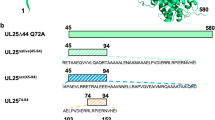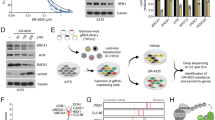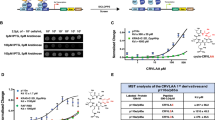Abstract
We have previously shown that a 20 amino acid peptide derived from the third ankyrin-like repeat of the p16CDKN2/INK4a (p16) tumour suppressor protein (residues 84 – 103 of the human p16 protein) can bind to cdk4 and cdk6 and inhibit cdk4-cyclin D1 kinase activity in vitro as well as block cell cycle progression through G1. Substitution of two valine residues corresponding to amino acids 95 and 96 (V95A and V96A) of the p16 peptide reduces the binding to cdk4 and cdk6 and increases its IC0.5 for kinase inhibition approximately threefold when linked to the Antennapedia homeodomain carrier sequence. The same mutations increase the IC0.5 approximately fivefold in the p16 protein. Substitution of aspartic acid 92 by alanine instead increases the binding of the peptide to cdk4 and cdk6 and the kinase inhibitory activity. The p16 peptide blocks S-phase entry in non-synchronized human HaCaT cells by approximately 90% at a 24 μM concentration. The V95A and V96A double substitution minimizes the cell cycle inhibitory capacity of the peptide whereas the D92A substitution increases its capacity to block cell cycle progression. A deletion series of the p16 derived peptide shows that a 10 residue peptide still retains cdk4-cyclin D1 kinase and cell cycle inhibitory activity. The p16 peptide inhibited S-phase entry in five cell lines tested, varying between 47 – 75%, but had only a limited (11%) inhibitory effect in the pRb negative Saos-2 cells at a concentration of 24 μM. Like the full length p16 protein, the p16 peptide does not inhibit cyclin E dependent cdk2 kinase activity in vitro. These data suggest that acute inhibition of CDK-cyclin D activity by a peptide derived from the INK4 family will stop cells in late G1 in a pRb dependent fashion.
This is a preview of subscription content, access via your institution
Access options
Subscribe to this journal
Receive 50 print issues and online access
$259.00 per year
only $5.18 per issue
Buy this article
- Purchase on Springer Link
- Instant access to full article PDF
Prices may be subject to local taxes which are calculated during checkout
Similar content being viewed by others
Author information
Authors and Affiliations
Rights and permissions
About this article
Cite this article
Fåhraeus, R., Laín, S., Ball, K. et al. Characterization of the cyclin-dependent kinase inhibitory domain of the INK4 family as a model for a synthetic tumour suppressor molecule. Oncogene 16, 587–596 (1998). https://doi.org/10.1038/sj.onc.1201580
Received:
Revised:
Accepted:
Published:
Issue Date:
DOI: https://doi.org/10.1038/sj.onc.1201580
Keywords
This article is cited by
-
Strategic Approaches to Improvise Peptide Drugs as Next Generation Therapeutics
International Journal of Peptide Research and Therapeutics (2023)
-
PLP2-derived peptide Rb4 triggers PARP-1-mediated necrotic death in murine melanoma cells
Scientific Reports (2022)
-
Single-cell RNA sequencing for the identification of early-stage lung cancer biomarkers from circulating blood
npj Genomic Medicine (2021)
-
Evaluation of the use of therapeutic peptides for cancer treatment
Journal of Biomedical Science (2017)
-
CPP2-p16MIS treatment–induced colon carcinoma cell death in vitro and prolonged lifespan of tumor-bearing mice
BMC Cancer (2016)



